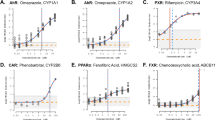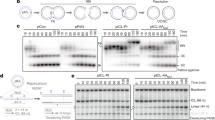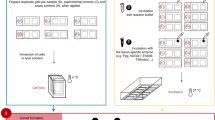Abstract
THE relationship between mutagenesis and carcinogenesis is still a matter of controversy1. The problem is particularly unresolved with respect to liver cancer induced by chemicals. Although hepato-carcinogenic nitrosamines are known to alkylate liver DNA in vivo2, similar binding to liver DNA in vivo has not been reported for the two other most intensively studied groups of liver carcinogens, namely, the fiuorenamines and the aminoazo dyes. Although, at present, one cannot make definitive interpretations of the functional significance (with respect either to DNA replication or to DNA transcription) of the binding of a carcinogen to the DNA in a liver cell, studies are needed which correlate carcinogenicity of various compounds with their binding in vivo to gene material. This report describes the binding of the strongly hepato-carcinogenic agent 2-acetamidofluorene3 (N-2-fluorenylacetamide, AAF) to rat liver DNA after intra-peritoneal injection. In a parallel in vivo experiment the aromatic hydrocarbon, 3 (or 20) -methylcholanthrene (MC), which is not carcinogenic for rat liver4 (although it does cause significant alterations in both RNA5 and protein6 synthesis in this organ), was found not to bind to rat liver DNA.
This is a preview of subscription content, access via your institution
Access options
Subscribe to this journal
Receive 51 print issues and online access
$199.00 per year
only $3.90 per issue
Buy this article
- Purchase on Springer Link
- Instant access to full article PDF
Prices may be subject to local taxes which are calculated during checkout
Similar content being viewed by others
References
Burdette, W. J., Cancer Res., 15, 201 (1955); Symp. Action of Mutagenic and Carcinogenic Agents, J. Cell. Comp. Physiol., 64, Suppl. 1 (1964).
Magee, P. N., and Farber, E., Biochem. J., 83, 114 (1962).
Weisburger, E. K., and Weisburger, J. H., Adv. Cancer Res., 5, 331 (1958).
Hartwell, J. L., Survey of Compounds Which Have Been Tested for Carcinogenic Activity, second ed. (Washington, U.S. Public Health Service 1951).
Loeb, L. A., and Gelboin, H. V., Proc. U.S. Nat. Acad. Sci., 52, 1219 (1964).
Conney, A. H., Miller, E. C., and Miller, J. A., Cancer Res., 16, 450 (1956); J. Biol. Chem., 228, 753 (1957). Gelboin, H. V., Biochim. Biophys. Acta, 91, 130 (1964).
Sporn, M. B., Wanko, T., and Dingman, W., J. Cell Biol., 15, 109 (1965). Dingman, C. W., and Sporn, M. B., Science, 149, 1251 (1965).
Fisher, W. D., Cline, G. B., and Anderson, N. G., Anal. Biochem., 9, 477 (1964).
Kit, S., Biochim. Biophys. Acta, 51, 198 (1961). Schildkraut, C., Marmur, J., and Doty, P., J. Mol. Biol., 4, 430 (1962).
Thomas, C. A., and Berns, K. I., J. Mol. Biol., 3, 277 (1961).
Marroquin, F., and Farber, E., Biochim. Biophys. Acta, 55, 403 (1962).
Brookes, P., and Lawley, P. D., Nature, 202, 781 (1964). Brookes, P., and Lawley, P. D., J. Cell. Comp. Physiol., 64, Suppl. 1, 111 (1964).
Dingman, C. W., and Sporn, M. B., Science, 149, 1251 (1965).
Author information
Authors and Affiliations
Rights and permissions
About this article
Cite this article
SPORN, M., DINGMAN, C. 2-Acetamidofluorene and 3-Methylcholanthrene: Differences in Binding to Rat Liver Deoxyribonucleic Acid in vivo. Nature 210, 531–532 (1966). https://doi.org/10.1038/210531a0
Issue Date:
DOI: https://doi.org/10.1038/210531a0
This article is cited by
-
Nature and nurture – lessons from chemical carcinogenesis
Nature Reviews Cancer (2005)
-
Vitamin A Deficiency enhances Binding of Benzo(a)pyrene to Tracheal Epithelial DNA
Nature (1974)
-
�ber die Aktivierung krebserzeugender aromatischer Amine im Stoffwechsel
Klinische Wochenschrift (1970)
Comments
By submitting a comment you agree to abide by our Terms and Community Guidelines. If you find something abusive or that does not comply with our terms or guidelines please flag it as inappropriate.



